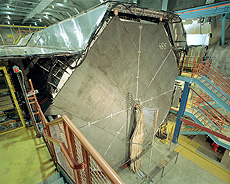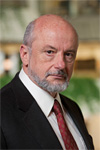|
Have a safe day!
Tuesday, June 5
Noon
Undergraduate Lecture Series (NOTE LOCATION) - Curia II
Speaker: Herman White, Fermilab
Title: Fermilab: An Introduction
3:30 p.m.
DIRECTOR'S COFFEE BREAK - 2nd Flr X-Over
4 p.m.
Accelerator Physics and Technology Seminar - One West
Speaker: Puneet Jain, Brookhaven National Laboratory
Title: Studies on 704 MHz Five-Cell Superconducting RF Cavity
Wednesday, June 6
3:30 p.m.
DIRECTOR'S COFFEE BREAK - 2nd Flr X-Over
4 p.m.
Fermilab Colloquium - One West
Speaker: Lucie Linssen, CERN
Title: Physics and Detectors at the CLIC Linear e+e- Collider
Click here for NALCAL,
a weekly calendar with links to additional information.
Upcoming conferences
|
|
Tuesday, June 5
- Breakfast: Bagel sandwich
- Chicken & rice soup
- Meatball sub
- Smart cuisine: Beef stroganoff
- Smart cuisine: Chicken stew w/ dumplings
- Peppered beef
- Assorted calzones
- Nachos supreme
Wilson Hall Cafe Menu
|
|
Wednesday, June 6
Lunch
- Sesame-chile chicken w/ watermelon salsa
- Orzo
- Citrus chiffon cake
Friday, June 8
Dinner
Closed
Chez Leon Menu
Call x3524 to make your reservation.
|
|
Help make Fermilab Today better: take the survey
How can we make Fermilab Today better? We want to hear from you.
The Fermilab Today staff is conducting a survey to learn how we can improve our publication, both for Fermilab employees and for readers outside the laboratory.
Today readers will receive an email from today@fnal.gov with a link to the online questionnaire. For security reasons, the link will first take you to a Fermilab webpage, confirming that it's trustworthy. You'll then be directed to the actual survey page, hosted by snap.com.
Please complete the survey by June 22. It will take 10 to 15 minutes to complete and your answers will be confidential. Most importantly, your feedback will help make Fermilab Today a better publication.
We hope to hear from you soon!
—Your Fermilab Today team
|
Fermilab experiment announces world's best measurement of key property of neutrinos

| The MINOS far detector is located in the Soudan Underground Laboratory in Minnesota. Image: Fermilab |
Fermilab experiment announces world's best measurement of key property of neutrinos
Batavia, Illinois—Scientists from the MINOS experiment at the Department of Energy's Fermi National Accelerator Laboratory have revealed the world's most precise measurement of a key parameter that governs the transformation of one type of neutrino to another. The results confirm that neutrinos and their antimatter counterparts, antineutrinos, have similar masses as predicted by most commonly accepted theories that explain how the subatomic world works.
MINOS caused a jolt in the physics world in 2010 when it announced that a measurement of this parameter, called delta m squared, showed a surprisingly large difference between the masses of neutrinos and antineutrinos. A subsequent 2011 measurement with increased statistics appeared to bring the neutrino and antineutrino masses closer in sync. With twice as much antineutrino data collected since its 2011 result, scientists confirm that the gap has closed. This upholds predictions and provides crucial information for many other neutrino experiments around the globe.
The new measurement is one of several announced this week by the MINOS experiment at the Neutrino 2012 conference in Kyoto, Japan. These are the final results from the first phase of the MINOS experiment.
"At the end of its initial seven-year run, MINOS has proven that it has been an incredibly successful long-baseline neutrino experiment," said Fermilab's Rob Plunkett, MINOS co-spokesperson. "We look forward to the next phase, when we will search for a new type of neutrino."
MINOS scientists also announced this week their latest measurement of the search for a rare phenomenon, the transformation of muon neutrinos into electron neutrinos. The Daya Bay experiment in China and the RENO experiment in Korea made headlines earlier this year with their measurements of this transformation, observed in neutrinos generated by nuclear reactors.
To measure the transformation of one type of neutrino to another, the MINOS experiment sends a beam of muon neutrinos 450 miles (735 kilometers) through the earth from the Main Injector accelerator at Fermilab to a 5,000-ton neutrino detector located half a mile underground in the Soudan Underground Laboratory in northern Minnesota. The experiment uses two almost identical detectors: the detector at Fermilab is used to check the purity of the muon neutrino beam, and the detector at Soudan looks for electron and muon neutrinos. The neutrinos’ trip from Fermilab to Soudan takes about 2.5 milliseconds, giving the neutrinos enough time to change their identities.
With its full data set collected, MINOS recorded a total of 21 electron-neutrino-like events on top of a background of 79. This represents 40% more data than its 2011 measurement of this transformation. The larger data set allowed MINOS scientists to improve their measurement of a parameter that describes this transformation, called sin22θ13. The new measurement remains consistent with the experiment’s previous measurements and provides an important clue to understanding the puzzle of neutrinos – how they transform from one type to another, and which of the three neutrino types is the most massive.
Read more
|
symmetry available online
The June online-only issue of symmetry magazine is now available here, featuring a primer on the muon, a story on how accelerator beams can be used for detecting cancer and much more. To get future issues delivered directly to your inbox once a month, subscribe to the symmetry email update list.
|
'Schrödinger's hat' could spy on quantum particles
From physicsworld.com, June 4, 2012
An international team of physicists has proposed a new device that could detect the presence of waves or particles while barely disturbing them. Called a "Schrödinger's hat", the device has not yet been built in the lab but the team believes that it could someday be used as a new type of sensor for quantum-information systems.
In the microscopic world of quantum mechanics, direct observation of the property of a particle – the position of an electron, for example – causes the collapse of the particle's wavefunction. The result is that the particle that you set out to measure has been changed in a significant way.
In the early 1990s, physicists Avshalom Elitzur and Lev Vaidman at Tel Aviv University in Israel pointed out that it is not always necessary to observe particles directly to learn something of their nature. The researchers imagined a pile of bombs, each of which is designed to be triggered by the absorption of a single photon. Some of the bombs are duds; through these, photons pass unimpeded. One could check whether a bomb is working by firing a photon at it but, if the bomb were indeed to be working, it would be destroyed in the process. Would there be a way to weed out some of the working bombs without destroying them?
Read more |
|
Planning is everything
 |
Fermilab Director
Pier Oddone |
Once a year each of the Office of Science laboratories presents their plans for the future to Director Bill Brinkman, Pat Dehmer, the associate directors of the six Office of Science programs and additional DOE staff experts. In many ways Fermilab, as a single-program laboratory, has a simpler presentation to make than some of the other labs: we only have to present a compelling program in particle physics. In other ways our presentation is much more complex. We depend entirely on the health of one program that requires major investments during this time of fiscal austerity. We must convince our important audience that these investments in particle physics pay off, even when measured in comparison with other scientific priorities.
Tomorrow we present our plans. We will describe not only the very exciting program through 2020 that studies the mysteries of neutrinos and looks for signs of new physics through the extraordinary sensitivity of rare processes, but also the long-term future of the laboratory. Our vision for a program beyond 2020 has been anchored on the Long-Baseline Neutrino Experiment and on Project X. On March 19 we received a letter from Bill Brinkman that stated that LBNE as currently conceived could not be funded within the expected budget envelope for Office of Science and charged us to present a phased approach or alternatives, with physics productivity at every stage. We have answered the charge through the work of the LBNE Reconfiguration Steering Committee, the Physics Working Group, the Engineering/Cost Working Group, and with input from the physics community. At this stage we have prepared an interim report that will be finalized in the next month after further discussions with DOE. On Wednesday we will present three viable options for the first phase of LBNE:
- Using the existing NuMI beamline in the low-energy configuration with a 30-kton liquid-argon time projection chamber (LAr-TPC) surface detector 14 mrad off-axis at Ash River in Minnesota, 810 km from Fermilab.
- Using the existing NuMI beamline in the low-energy configuration with a 15 kton LAr-TPC detector underground (at the 2,340-ft level) on-axis at the Soudan Lab in Minnesota, 735 km from Fermilab.
- Constructing a new low-energy LBNE beamline with a 10-kton LAr-TPC surface detector on-axis at Homestake in South Dakota, 1,300 km from Fermilab.
While each of these options is more sensitive than the others in a particular physics domain, the Steering Committee in its discussions strongly favored the option to build a new beamline to Homestake with an initial 10-kton LAr-TPC detector on the surface. The physics reach of this first phase is very strong; moreover this option is seen by the Steering Committee as a start of a long-term world-leading program that would achieve the full goals of LBNE over time and allow for the most incisive studies of the Standard Model. Over the next few weeks we want to set a clear path forward with DOE so that we can proceed in an orderly way to the next steps in the life of the project, with CD-1 hopefully late this year or early next year.
|
Linear collider school now accepting applications
The Seventh International Accelerator School for Linear Colliders, which takes place this year in Indore, India, is accepting applications through July 20.
The school, whose target students are graduate students, postdoctoral fellows and junior researchers, will focus on future lepton colliders, including the ILC, CLIC and the muon collider. It will cover both basic materials and advanced topics in accelerator physics and both warm and superconducting radio-frequency technology.
The school program runs from Nov. 27 to Dec. 8. and is being organized by the ILC Global Design Effort, the CLIC Study and the ICFA Beam Dynamics Panel. Admitted students will be eligible for full or partial financial aid covering expenses including airfare, lodging, meals, local transportation and school supplies.
"The next generation of high-energy physics colliders after the LHC will have a long timescale from conception to construction and operation," said Weiren Chou, chair of the ICFA Beam Dynamics Panel. "This is an opportunity to train the new generation of scientists."
Visit the school website to apply or for more information.
|
|